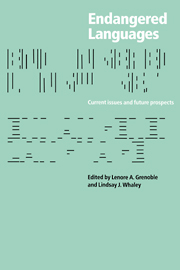Book contents
- Frontmatter
- Contents
- Preface
- List of abbreviations and symbols
- Part I General issues
- Part II Language-community responses
- Part III What is lost: language diversity
- 7 The significance of diversity in language endangerment and preservation
- 8 On endangered languages and the importance of linguistic diversity
- 9 Living words and cartoon translations: Longhouse “texts” and the limitations of English
- 10 Documenting rhetorical, aesthetic, and expressive loss in language shift
- Part IV Mechanisms of language loss
- Appendix
- References
- Index of languages
- Index of names
- General index
9 - Living words and cartoon translations: Longhouse “texts” and the limitations of English
Published online by Cambridge University Press: 05 June 2012
- Frontmatter
- Contents
- Preface
- List of abbreviations and symbols
- Part I General issues
- Part II Language-community responses
- Part III What is lost: language diversity
- 7 The significance of diversity in language endangerment and preservation
- 8 On endangered languages and the importance of linguistic diversity
- 9 Living words and cartoon translations: Longhouse “texts” and the limitations of English
- 10 Documenting rhetorical, aesthetic, and expressive loss in language shift
- Part IV Mechanisms of language loss
- Appendix
- References
- Index of languages
- Index of names
- General index
Summary
Introduction
All across Native North America it is hard not to encounter an almost universal concern over language erosion in relation to Native American languages. In some cases individuals and communities recognize that loss or near-loss of traditional languages has already occurred, and they wrestle with the consequences, as well as with prospects for at least partial restoration. In other cases the threat is more distant but still looming; the issues are framed in terms of saving and revitalizing these languages. Invariably, though, there is a sense that not much time is left.
In many cases the work of professional linguists, including some represented in this collection, has been invaluable in helping these communities to evaluate the extent of language erosion, and to develop practical responses. In the midst of their efforts to understand these situations scientifically, it is equally important to solicit commentary from members of impacted communities who are not linguists. For Native American people these issues are rooted in deep soils of human identity, thus giving them an urgency that is an inseparable quality of the facts we are all trying to understand.
In the several traditional settings I have encountered in Native American communities, knowledge is neither expressed, nor conceived without reference to its background, sources, and affective qualities. The formal “texts” of such expressions are but skeletons around which a body of interpretation – often in terms of personal experience – is hung. It is with this in mind that I have not hestitated to include a first-person dimension to these remarks.
- Type
- Chapter
- Information
- Endangered LanguagesLanguage Loss and Community Response, pp. 217 - 233Publisher: Cambridge University PressPrint publication year: 1998
- 6
- Cited by

